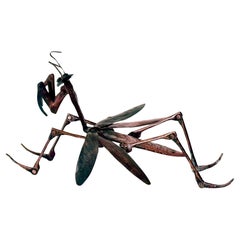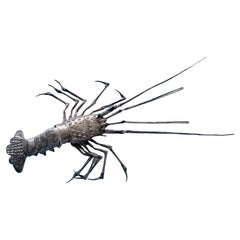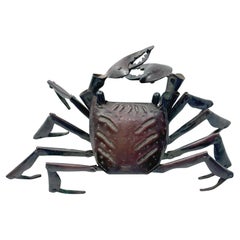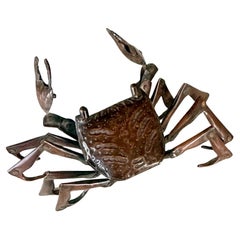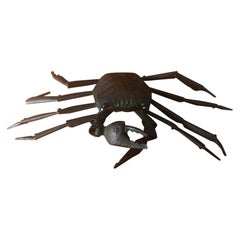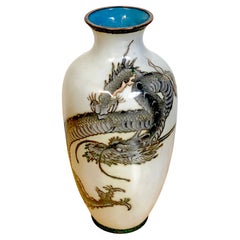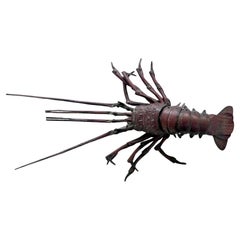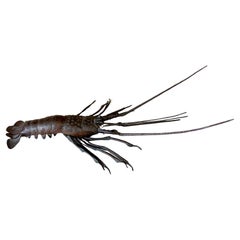Myochin Hiroyoshi Mobiles and Kinetic Sculptures
to
4
4
4
4
3
1
4
4
4
4
Height
to
Width
to
4
4
4
4
50
11
11
10
Creator: Myochin Hiroyoshi
Japanese Articulate Praying Mantis Jizai Okimono Myochin Hiroyoshi Meiji
By Myochin Hiroyoshi
Located in Atlanta, GA
A rare articulate praying mantis made by Myochin Hiroyoshi in the late Meiji Period circa 1890-1900s. As an ornamental display item, this type of item is known in Japanese as Jizai O...
Category
Early 20th Century Japanese Meiji Myochin Hiroyoshi Mobiles and Kinetic Sculptures
Materials
Copper
Rare Japanese Articulate Silver Lobster Jizai Okimono Myochin Hiroyoshi Meiji
By Myochin Hiroyoshi
Located in Atlanta, GA
On offer is a rare articulate spiny lobster (Ise-Ebi) in pure silver made by Myochin Hiroyoshi in the late Meiji Period circa 1890-1900s. As an ornamental display item, this type of ...
Category
Early 20th Century Japanese Meiji Myochin Hiroyoshi Mobiles and Kinetic Sculptures
Materials
Silver
Small Japanese Articulate Crab Jizai Okimono Meiji Period Signed
By Myochin Hiroyoshi
Located in Atlanta, GA
A small copper crab with articulated legs made by Myochin Hiroyoshi in the late Meiji Period circa 1890-1900s. One of the pair (the other one is listed separately LU945037876072, but...
Category
Early 20th Century Japanese Japonisme Myochin Hiroyoshi Mobiles and Kinetic Sculptures
Materials
Copper
Small Japanese Articulate Crab Jizai Okimono Meiji Period Signed
By Myochin Hiroyoshi
Located in Atlanta, GA
A small copper crab with articulated legs made by Myochin Hiroyoshi in the late Meiji Period circa 1890-1900s. One of the pair (the other one is listed separately LU945044034102, bu...
Category
Early 20th Century Japanese Japonisme Myochin Hiroyoshi Mobiles and Kinetic Sculptures
Materials
Copper
Related Items
Antique Signed Japanese Articulated Crab Sculpture in Copper Jizai Okimono
Located in San Diego, CA
Antique signed Japanese articulated crab sculpture (Jizai OKimono) in copper, circa 1910s. The piece is well detailed and patinated.
Category
Early 20th Century Japanese Meiji Myochin Hiroyoshi Mobiles and Kinetic Sculptures
Materials
Copper
$960 Sale Price
20% Off
H 1.375 in W 5.5 in D 2 in
Exquisite Japanese Wireless Cloisonné Dragon Motif Vase, Meiji / Taisho Period
Located in West Palm Beach, FL
Japanese Wireless Cloisonné Enamel Vase, likely from the Meiji period (1868–1912) or possibly the early Taisho period (1912–1926). The vase features a dynamic depiction of a Japanese...
Category
Early 20th Century Japanese Meiji Myochin Hiroyoshi Mobiles and Kinetic Sculptures
Materials
Copper
Signed Japanese Meiji Period Bronze Crab (E) Okimono
Located in Chapel Hill, NC
Signed Japanese okimono of a realistically modeled crab raised up on its toes and with claws raised. One of 5 designated by (E) in the title.
Category
Late 19th Century Japanese Meiji Antique Myochin Hiroyoshi Mobiles and Kinetic Sculptures
Materials
Bronze
Japanese Cloisonne Box by Inaba, Meiji Period, circa 1900, Japan
By Inaba Cloisonne Co.
Located in Austin, TX
A fine Japanese cloisonne hinged box with pheasant and autumn foliage, by Inaba Nanaho and the Inaba Cloisonne Company, Meiji period, circa 1900, ...
Category
Early 1900s Japanese Meiji Antique Myochin Hiroyoshi Mobiles and Kinetic Sculptures
Materials
Copper, Enamel, Metal
Japanese Meiji Period Sterling Silver 2 Handled Basket by Katsu Miyamoto
By Miyamoto Shoko 1
Located in Dallas, TX
PRESENTING a GORGEOUS, VERY HIGH QUALITY and EXTREMELY RARE piece of Japanese Meiji Period Sterling Silver 2 Handled Basket by Katsu Miyamoto.
EXQUISITE, EXCEPTIONAL, RARE & IMPORTANT!
This is definitely a Meiji Period piece due to the fact that it is marked with the sterling silver mark “jungin”.
The Meiji period was from 1868 to 1912 and in 1928 a law was introduced in Japan compelling the use of decimal marks for silver.
This pre-dates that decimalization law.
We are of the opinion that it is from circa 1900.
Miyamoto Shoko was founded in 1880 as the first silverware specialty shop. In 1899, Miyamoto Shoko’s silverwares were ordered by the family members of the Emperor of Japan, and to this day, they are making fine and graceful handicrafts with skillful craftsmen.
Loved by numerous customers since the Meiji era, Miyamoto Shoko’s products have also been given to Princess Mako and Princess Kako of Akishino, as well as Princess Aiko Toshinomiya, on their birthdays.
Katsu Miyamoto (宮本勝), in 1880, in order to increase the sales of tobacco and cigarettes to foreigners founded the Moyamoto Shoko company, which produced different silverwares in general and particularly silver cigarette cases. Miyamoto’s first name, Katsu (勝) in some sources is written as “Masaru”, since 勝 kanji can be pronounced in both ways.
This basket is of the HIGHEST QUALITY imaginable!
The top of the basket has the MOST GORGEOUS repousse work of flowers, probably lotus flowers, with leaves and foliage. It has an underlying chevron effect chasing, reflecting parquetry.
The 2 handles are cast in the form of bamboo handles.
The rim of the top likewise is cast as bamboo.
The base is equally stunning in a different way!
It is chased with a chevron effect, like parquetry flooring and the four feet simulate pieces of sliced bamboo with an interlinking gallery of support columns, likewise, simulating bamboo.
The QUALITY of WORKMANSHIP is OUTSTANDING!
The pieces weighs exactly 525 grams.
This piece takes my breath away!
This is one for the SERIOUS COLLECTOR of EXQUISITE AND RARE Japanese silver. You will not find another like it, for sale ANYWHERE ELSE IN THE WORLD …… I know as I have searched!
Provenance: Acquired from a Dallas Private Collector.
Dimensions: 9.6 inches wide, 7.6 inches deep and 2.75 inches tall ( 7.25 inches tall with handles up)
Condition: Very good. It looks like the base 4 legged gallery, has been repaired/re-attached to the base, but otherwise it is excellent and of Museum quality.
The Meiji period (明治時代 Meiji-jidai?), also known as the Meiji era, is a Japanese era which extended from October 23, 1868 through July 30, 1912.[1] This period represents the first half of the Empire of Japan during which Japanese society moved from being an isolated feudal society to its modern form. Fundamental changes affected its social structure, internal politics, economy, military, and foreign relations. The period corresponded with the reign of Emperor Meiji after 1868, and lasted until his death in 1912. It was succeeded by the Taishō period upon the accession of Emperor Taishō to the throne.
Solid silver pieces...
Category
Early 20th Century Japanese Meiji Myochin Hiroyoshi Mobiles and Kinetic Sculptures
Materials
Sterling Silver
$7,250
H 7.25 in W 9.6 in D 7.6 in
Japanese Silver Incense Burner, Akoda Koro, by Nomura, Meiji Period, Japan
Located in Austin, TX
A lovely and luxurious Japanese silver incense burner of lobed melon form, akoda koro, marked jungin and signed Nomura, Meiji Period, circa 1900, Japan.
The silver koro...
Category
1910s Japanese Meiji Vintage Myochin Hiroyoshi Mobiles and Kinetic Sculptures
Materials
Silver, Sterling Silver
19th Century Japanese Bronze Vase With Gilt Decoration, Meiji Period
Located in Stamford, CT
19th century Meiji Period diminutive bronze vase with lovely etched and applied decoration. A raised gilt bird is shown flying above etched bamboo on one side, gilt applied lilies wi...
Category
Late 19th Century Japanese Meiji Antique Myochin Hiroyoshi Mobiles and Kinetic Sculptures
Materials
Bronze
Large Japanese Meiji Period Bronze Crab (C) Okimono
Located in Chapel Hill, NC
Realistically modeled Japanese okimono of a crab raised on its toes. I of 5 designated by the (C) in the title.
Category
Late 19th Century Japanese Meiji Antique Myochin Hiroyoshi Mobiles and Kinetic Sculptures
Materials
Bronze
Japanese Meiji Period Cloisonne Enamel Sake Pot
Located in Newark, England
Fine Japanese Meiji period cloisonne enamel Sake pot. The Sake pot of rounded form with with clean edges profusely decorated with blossoming flowers throughout upon a black ground ba...
Category
Late 19th Century Japanese Meiji Antique Myochin Hiroyoshi Mobiles and Kinetic Sculptures
Materials
Metal, Enamel
Large Japanese Meiji Period Bronze Crab (B) Okimono
Located in Chapel Hill, NC
Large Japanese naturalistically modeled bronze okimono in the form of a crab. One of 5 designated by the (B) in the title.
Category
Late 19th Century Japanese Meiji Antique Myochin Hiroyoshi Mobiles and Kinetic Sculptures
Materials
Bronze
Japanese Pair Meiji Cloisonne Bottle Vases with Scattered Floral Designs
Located in Bishop's Stortford, Hertfordshire
A fine pair Japanese Meiji period cloisonne bottle shaped vases decorated with scattered floral patterns and dating between 1868 and 1912. The vases are lightly made standing on a fl...
Category
19th Century Japanese Meiji Antique Myochin Hiroyoshi Mobiles and Kinetic Sculptures
Materials
Brass
$606 / set
H 7.88 in Dm 4.34 in
Jizai Okimono Koi Carp
By Mariusz Milewski
Located in London, GB
Jizai Okimono – Koi Carp (2022)
Handcrafted Articulated Sculpture Collector’s Piece
Immerse yourself in the elegance of Japanese metalwork with this one-of-a-kind Jizai Okimono scul...
Category
21st Century and Contemporary British Meiji Myochin Hiroyoshi Mobiles and Kinetic Sculptures
Materials
Steel
Previously Available Items
Japanese Articulate Lobster Jizai Okimono Myochin Hiroyoshi Meiji Period
By Myochin Hiroyoshi
Located in Atlanta, GA
On offer is an articulate spiny lobster (Ise-Ebi) made by Myochin Hiroyoshi in the late Meiji Period circa 1890-1900s. As an ornamental display item, this type of item is known in Ja...
Category
Early 20th Century Japanese Meiji Myochin Hiroyoshi Mobiles and Kinetic Sculptures
Materials
Copper
Japanese Articulate Lobster Jizai Okimono Myochin Hiroyoshi Meiji Period
By Myochin Hiroyoshi
Located in Atlanta, GA
An articulate spiny lobster (Ise-Ebi) as an ornamental display item, known in Japanese as Jizai Okimono, was made by Myochin Hiroyoshi in the late Meiji Period circa 1890-1900s. The ...
Category
Early 20th Century Japanese Japonisme Myochin Hiroyoshi Mobiles and Kinetic Sculptures
Materials
Copper
Japanese Articulate Lobster Jizai Okimono Meiji Period Signed
By Myochin Hiroyoshi
Located in Atlanta, GA
An articulate spiny lobster (Ise-Ebi) as an ornamental display item, known in Japanese as Jizai Okimono, was made by Myochin Hiroyoshi in the late Meiji ...
Category
Early 20th Century Japanese Japonisme Myochin Hiroyoshi Mobiles and Kinetic Sculptures
Materials
Copper
Large Japanese Articulate Lobster Okimono Meiji Period Signed
By Myochin Hiroyoshi
Located in Atlanta, GA
An articulate spiny lobster (Ise-Ebi) as an ornamental display item, known in Japanese as Jizai Okimono, was made by Myochin Hiroyoshi in the late Meiji ...
Category
Early 20th Century Japanese Japonisme Myochin Hiroyoshi Mobiles and Kinetic Sculptures
Materials
Copper
Large Japanese Articulate Lobster Okimono Meiji Period Signed
By Myochin Hiroyoshi
Located in Atlanta, GA
An articulate spiny lobster (Ise-Ebi) as an ornamental display item, known in Japanese as Jizai Okimono, was made by Myochin Hiroyoshi in the late Meiji ...
Category
Early 20th Century Japanese Japonisme Myochin Hiroyoshi Mobiles and Kinetic Sculptures
Materials
Copper
Myochin Hiroyoshi mobiles and kinetic sculptures for sale on 1stDibs.
Myochin Hiroyoshi mobiles and kinetic sculptures are available for sale on 1stDibs. These distinctive items are frequently made of metal and are designed with extraordinary care. If you’re looking for additional options, many customers also consider mobiles and kinetic sculptures by Curtis Jeré, Ladies & Gentlemen Studio, and Kifu Augousti. Prices for Myochin Hiroyoshi mobiles and kinetic sculptures can differ depending upon size, time period and other attributes — on 1stDibs, these items begin at $3,000 and can go as high as $3,000, while a piece like these, on average, fetch $3,000.
